Vulnerability of Affordable Housing to Global Warming in South Africa: Case Study of a Masonry House in Johannesburg
Abstract
:1. Introduction
2. Materials and Methods
2.1. House Layout and Characteristics
2.2. Experimental Setup
2.3. Overheating Criteria
3. Results
3.1. Ground versus First Floor Spaces
3.2. Exceedance of Tmax
3.3. Results of the Overheating Assessment: Room 4
- In 2018 and 2019, the space violated criteria 1 and 2, resulting in a failure of the CIBSE assessment (i.e., the space overheated); however, in 2020, the space successfully met all three overheating criteria;
- All criteria were most severely violated in 2019; however, the performance against criterion 1 was the most striking, with approximately three to five times more hours of exceedance compared to 2018 and 2020, respectively;
- High outdoor temperatures recorded during October and November 2019 (Table 6) led to higher comfortable (Tcomf) and maximum (Tmax) temperatures during the period; nonetheless, the increase in these parameters was offset by the corresponding rise in indoor operative temperature (Top), which meant that Tmax was frequently exceeded during October and November 2019;
- The first-floor spaces were significantly affected by extreme temperatures, leading to a notable increase in both the duration and intensity of overheating. During the months of October and November 2019, the space experienced 12.5% exceedance hours, which was severe enough to suggest that the space failed to meet the requirements for the entire summer period (October–March), without requiring any further assessment (i.e., assuming all hours are below Tmax for the remaining summer months, the % hours above Tmax + 1 °C would still be approximately 4%).
3.4. Results of the Overheating Assessment: Room 2
4. Discussion
5. Conclusions
Funding
Data Availability Statement
Acknowledgments
Conflicts of Interest
References
- Urgent Climate Action Can Secure a Liveable Future for All. Available online: https://www.ipcc.ch/report/ar6/syr/downloads/press/IPCC_AR6_SYR_PressRelease_en.pdf (accessed on 21 March 2023).
- Mbokodo, I.; Bopape, M.-J.; Chikoore, H.; Engelbrecht, F.; Nethengwe, N. Heatwaves in the Future Warmer Climate of South Africa. Atmosphere 2020, 11, 712. [Google Scholar] [CrossRef]
- DST (Department of Science and Technology). South African Risk and Vulnerability Atlas; Department of Science and Technology: Pretoria, South Africa, 2010.
- Engelbrecht, F.A.; Adegoke, J.; Bopape, M.-J.; Naidoo, M.; Garland, R.; Thatcher, M.; McGregor, M.; Katzfey, J.; Werner, M.; Ichoku, C.; et al. Projections of rapidly rising surface temperatures over Africa under low mitigation. Environ. Res. Lett. 2015, 10, 085004. [Google Scholar] [CrossRef] [Green Version]
- Engelbrecht, F.A.; McGregor, J.L.; Engelbrecht, C.J. Dynamics of the Conformal-Cubic Atmospheric Model Projected Climate-Change Signal over Southern Africa. Int. J. Climatol. 2009, 29, 1013–1033. [Google Scholar] [CrossRef]
- Kruger, A.C.; Mbatha, S. Regional Weather and Climate of South Africa: Gauteng; South African Weather Service: Pretoria, South Africa, 2021. [Google Scholar]
- Taylor, J.; Wilkinson, P.; Davies, M.; Armstrong, B.; Chalabi, Z.; Mavrogianni, A.; Symonds, P.; Oikonomou, E.; Bohnenstengel, S.I. Mapping the Effects of Urban Heat Island, Housing, and Age on Excess Heat-Related Mortality in London. Urban Clim. 2015, 14, 517–528. [Google Scholar] [CrossRef]
- Santamouris, M. Recent Progress on Urban Overheating and Heat Island Research. Integrated Assessment of the Energy, Environmental, Vulnerability and Health Impact. Synergies with Global Climate Change. Energy Build. 2020, 207, 109482. [Google Scholar] [CrossRef]
- Niño 3.4 SST Index. Available online: https://psl.noaa.gov/enso/dashboard.lanina.html (accessed on 3 March 2023).
- El Niño Theme Page. Pacific Marine Environmental Laboratory. Available online: https://www.pmel.noaa.gov/elnino/impacts-of-el-nino (accessed on 13 March 2023).
- Coley, D.; Kershaw, T. Changes in Internal Temperatures within the Built Environment as a Response to a Changing Climate. Build. Environ. 2010, 45, 89–93. [Google Scholar] [CrossRef] [Green Version]
- Wang, H.; Chen, Q. Impact of Climate Change Heating and Cooling Energy Use in Buildings in the United States. Energy Build. 2014, 82, 428–436. [Google Scholar] [CrossRef] [Green Version]
- Porritt, S.M.; Cropper, P.C.; Shao, L.; Goodier, C.I. Ranking of Interventions to Reduce Dwelling Overheating during Heat Waves. Energy Build. 2012, 55, 16–27. [Google Scholar] [CrossRef]
- Escandón, R.; Suárez, R.; Sendra, J.J.; Ascione, F.; Bianco, N.; Mauro, G.M. Predicting the Impact of Climate Change on Thermal Comfort in A Building Category: The Case of Linear-Type Social Housing Stock in Southern Spain. Energies 2019, 12, 2238. [Google Scholar] [CrossRef] [Green Version]
- Dino, I.G.; Meral Akgül, C. Impact of Climate Change on the Existing Residential Building Stock in Turkey: An Analysis on Energy Use, Greenhouse Gas Emissions and Occupant Comfort. Renew Energy 2019, 141, 828–846. [Google Scholar] [CrossRef]
- Heracleous, C.; Michael, A. Assessment of Overheating Risk and the Impact of Natural Ventilation in Educational Buildings of Southern Europe under Current and Future Climatic Conditions. Energy 2018, 165, 1228–1239. [Google Scholar] [CrossRef]
- Ozarisoy, B. Energy Effectiveness of Passive Cooling Design Strategies to Reduce the Impact of Long-Term Heatwaves on Occupants’ Thermal Comfort in Europe: Climate Change and Mitigation. J. Clean Prod. 2022, 330, 129675. [Google Scholar] [CrossRef]
- Roshan, G.; Oji, R.; Attia, S. Projecting the Impact of Climate Change on Design Recommendations for Residential Buildings in Iran. Build. Environ 2019, 155, 283–297. [Google Scholar] [CrossRef] [Green Version]
- Andrić, I.; Corre, O.L.; Lacarrière, B.; Ferrão, P.; Al-Ghamdi, S.G. Initial Approximation of the Implications for Architecture due to Climate Change. Adv. Build. Energy Res. 2021, 15, 337–367. [Google Scholar] [CrossRef] [Green Version]
- Gupta, R.; Gregg, M. Preventing the Overheating of English Suburban Homes in a Warming Climate. Build. Res. Inf. 2013, 41, 281–300. [Google Scholar] [CrossRef]
- Hamdy, M.; Carlucci, S.; Hoes, P.-J.; Hensen, J.L.M. The Impact of Climate Change on the Overheating Risk in Dwellings—A Dutch Case Study. Build. Environ. 2017, 122, 307–323. [Google Scholar] [CrossRef]
- Mavrogianni, A.; Wilkinson, P.; Davies, M.; Biddulph, P.; Oikonomou, E. Building Characteristics as Determinants of Propensity to High Indoor Summer Temperatures in London Dwellings. Build. Environ. 2012, 55, 117–130. [Google Scholar] [CrossRef] [Green Version]
- Thapa, S. Risk of Overheating in Low-Rise Naturally Ventilated Residential Buildings of Northeast India—An Effect of Climate Change. Archit. Sci. Rev. 2022, 65, 14–41. [Google Scholar] [CrossRef]
- Abbas, K.; Li, S.; Xu, D.; Baz, K.; Rakhmetova, A. Do Socioeconomic Factors Determine Household Multidimensional Energy Poverty? Empirical Evidence from South Asia. Energy Policy 2020, 146, 111754. [Google Scholar] [CrossRef]
- Covary, T.; Du Preez, K.; Götz, T. Energy Efficient Air Conditioners. Wuppertal Institute for Climate, Environment and Energy. 2015. Available online: http://www.bigee.net/media/filer_public/2015/07/22/bigee_south_africa_ac_20150722.pdf (accessed on 7 March 2023).
- Wright, C.Y.; Wernecke, B.; Kapwata, T.; Kunene, Z.; Mathee, A.; Hey, J.V.; Theron, L. Perceptions of Thermal Comfort and Coping Mechanisms Related to Indoor and Outdoor Temperatures among Participants Living in Rural Villages in Limpopo Province, South Africa. South Afr. J. Psychol. 2022, 52, 449–459. [Google Scholar] [CrossRef]
- Naicker, N.; Teare, J.; Balakrishna, Y.; Wright, C.Y.; Mathee, A. Indoor Temperatures in Low Cost Housing in Johannesburg, South Africa. Int. J. Environ. Res. Public Health 2017, 14, 1410. [Google Scholar] [CrossRef] [PubMed] [Green Version]
- Mabuya, B.; Scholes, M. The Three Little Houses: A Comparative Study of Indoor and Ambient Temperatures in Three Low-Cost Housing Types in Gauteng and Mpumalanga, South Africa. Int. J. Environ. Res. Public Health 2020, 17, 3524. [Google Scholar] [CrossRef]
- Bradley, R.A. Assessing the Effectiveness of Several Passive Design Strategies Using the CIBSE Overheating Criteria: Case Study of an Earth Brick Shell House in Johannesburg, South Africa. Archit. Sci. Rev. 2022, 65, 232–246. [Google Scholar] [CrossRef]
- Bradley, R.A.; Gohnert, M.; Fitchett, A. Long-Term Monitoring of an Earth-Masonry Shell House in Johannesburg, South Africa: Thermal Performance. Proc. Inst. Civ. Eng.—Constr. Mater. 2021, 174, 21–33. [Google Scholar] [CrossRef]
- South African Weather Service. Annual State of the Climate 2019. Available online: https://www.weathersa.co.za/Documents/Corporate/Annual%20State%20of%20the%20Climate%202019.pdf (accessed on 4 March 2023).
- South African Weather Service. Annual State of the Climate 2020. Available online: https://www.weathersa.co.za/Documents/Corporate/Annual%20State%20of%20the%20Climate%202020_19032021121122.pdf (accessed on 4 March 2023).
- South African Weather Service. Annual State of the Climate 2021. Available online: https://www.weathersa.co.za/Documents/Corporate/Annual%20State%20of%20the%20Climate%202021_04042022114230.pdf (accessed on 4 March 2023).
- El Niño/Southern Oscillation (ENSO). Available online: https://www.ncei.noaa.gov/access/monitoring/enso/sst (accessed on 13 March 2023).
- SANS 10400-C; Application of the National Building Regulations—Part C: Dimensions. South African National Standards (SANS): Pretoria, South Africa, 2016.
- CIBSE. CIBSE Guide A: Environmental Design, 8th ed.; Chartered Institution of Building Services Engineers: London, UK, 2019; ISBN 9781906846541. [Google Scholar]
- SANS 10400-XA; Application of the National Building Regulations—Part X: Environmental Sustainability—Part XA: Energy Usage in Buildings. South African National Standards (SANS): Pretoria, South Africa, 2011.
- BS EN 15251; Indoor Environmental Input Parameters for Design and Assessment of Energy Performance of Buildings Addressing Indoor Air Quality, Thermal Environment, Lighting and Acoustics. British Standards Institution (BSI): London, UK, 2007.
- CIBSE TM52; The Limits of Thermal Comfort: Avoiding Overheating in European Buildings. Chartered Institution of Building Services Engineers: London, UK, 2013.
- Tuohy, P.G.; Humphreys, M.A.; Nicol, F.; Rijal, H.B.; Clarke, J.A. Occupant Behaviour in Naturally Ventilated and Hybrid Buildings. Am. Soc. Heat. Refrig. Air Cond. Eng. (ASHRAE) Trans. 2009, 115, 16–27. [Google Scholar]
- Conradie, D.C. South Africa’s Climatic Zones: Today, Tomorrow. In Proceedings of the International Green Building Conference and Exhibition: Future Trends and Issues Impacting on the Built Environment, Sandton, South Africa, 25–26 July 2012. [Google Scholar]
- World Health Organization. Climate Change, Heat and Health. 2022. Available online: https://www.who.int/news-room/factsheets/detail/climate-change-heat-and-health (accessed on 13 April 2023).
- Karimpour, M.; Belusko, M.; Xing, K.; Boland, J.; Bruno, F. Impact of Climate Change on the Design of Energy Efficient Residential Building Envelopes. Energy Build. 2015, 87, 142–154. [Google Scholar] [CrossRef]
- Dabaieh, M.; Wanas, O.; Hegazy, M.A.; Johansson, E. Reducing Cooling Demands in a Hot Dry Climate: A Simulation Study for Non-Insulated Passive Cool Roof Thermal Performance in Residential Buildings. Energy Build. 2015, 89, 142–152. [Google Scholar] [CrossRef] [Green Version]
- Pisello, A.L.; Castaldo, V.L.; Piselli, C.; Fabiani, C.; Cotana, F. Thermal Performance of Coupled Cool Roof and Cool Façade: Experimental Monitoring and Analytical Optimization Procedure. Energy Build. 2017, 157, 35–52. [Google Scholar] [CrossRef]
- Fitchett, A.; Govender, P.; Vallabh, P. An Exploration of Green Roofs for Indoor and Exterior Temperature Regulation in the South African Interior. Environ. Dev. Sustain. 2020, 22, 5025–5044. [Google Scholar] [CrossRef]
- Bradley, R.A. Mitigating the Potential of Overheating in an Earth-masonry Shell House Situated in Johannesburg through Passive Design Strategies. In Proceedings of the 5th Biennial Residential Building Design and Construction Conference, State College, PA, USA, 5–6 March 2020; Memari, A., Klinetob-Lowe, S., Eds.; Pennsylvania Housing Research Centre: University Park, PA, USA, 2020. [Google Scholar]
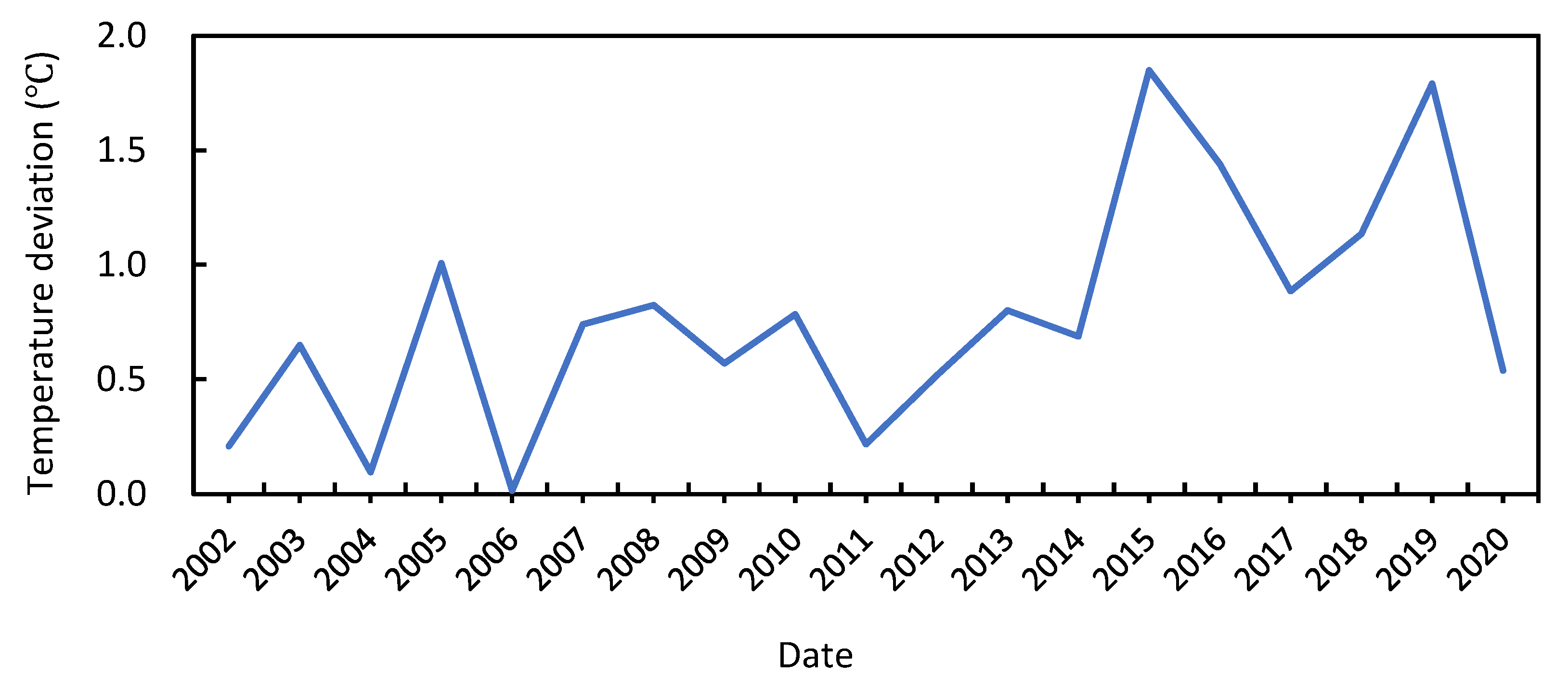
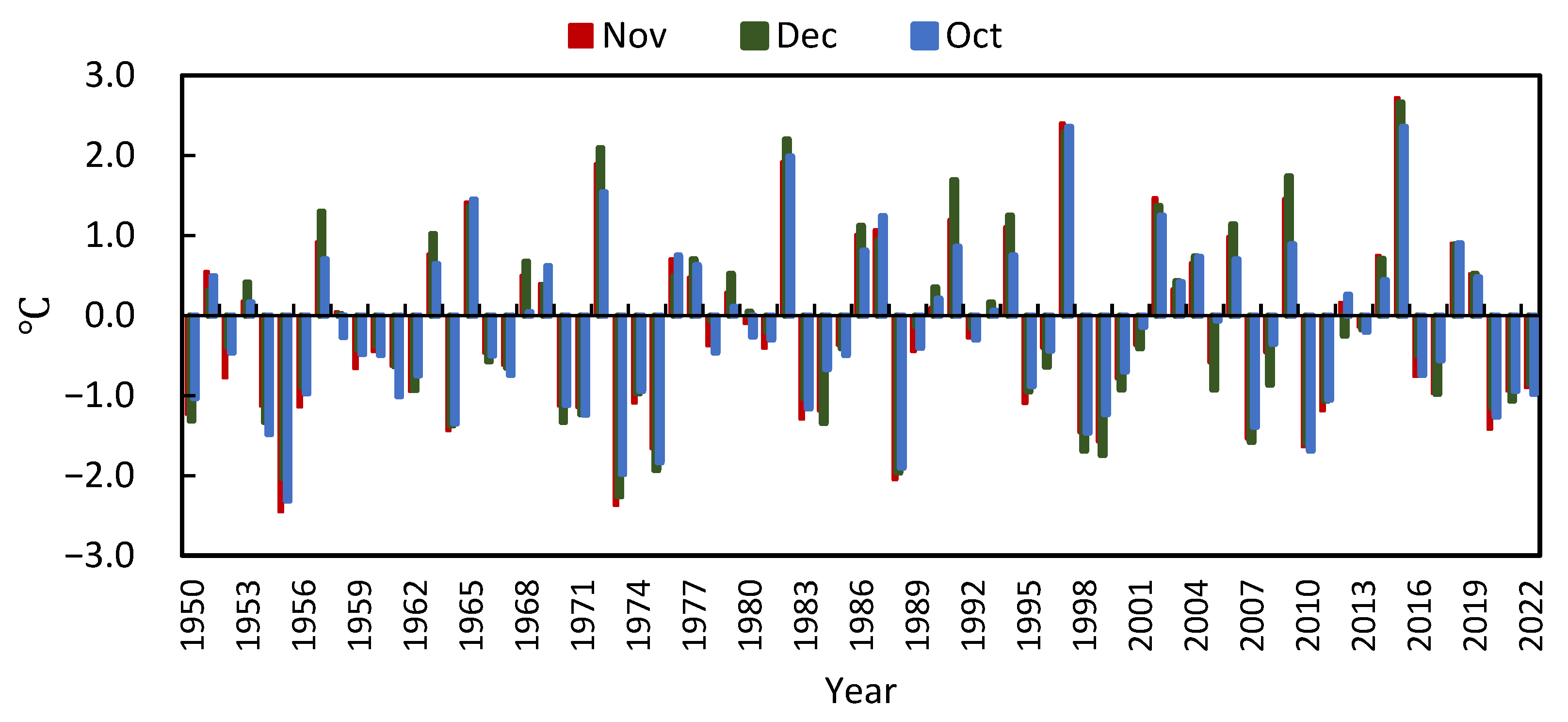
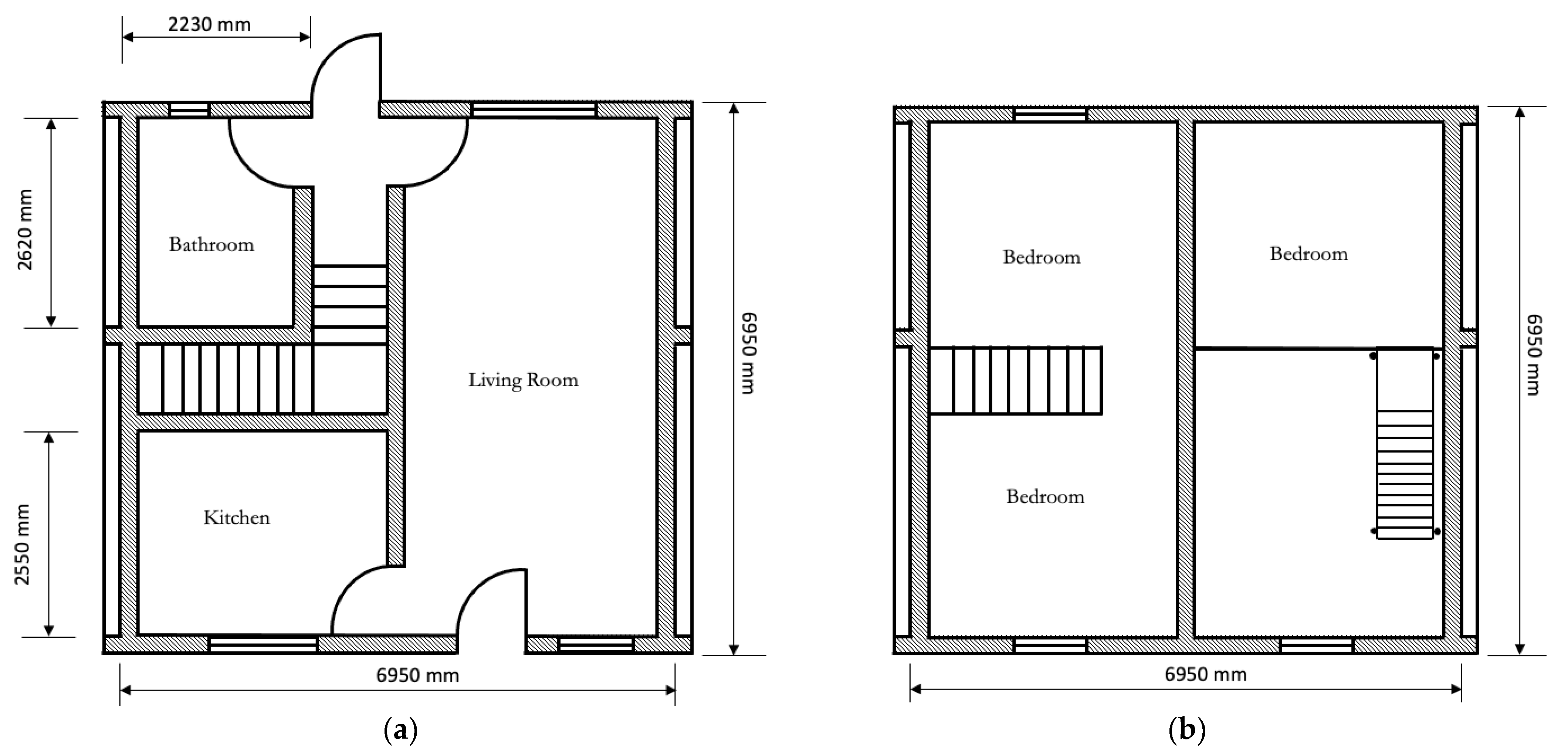

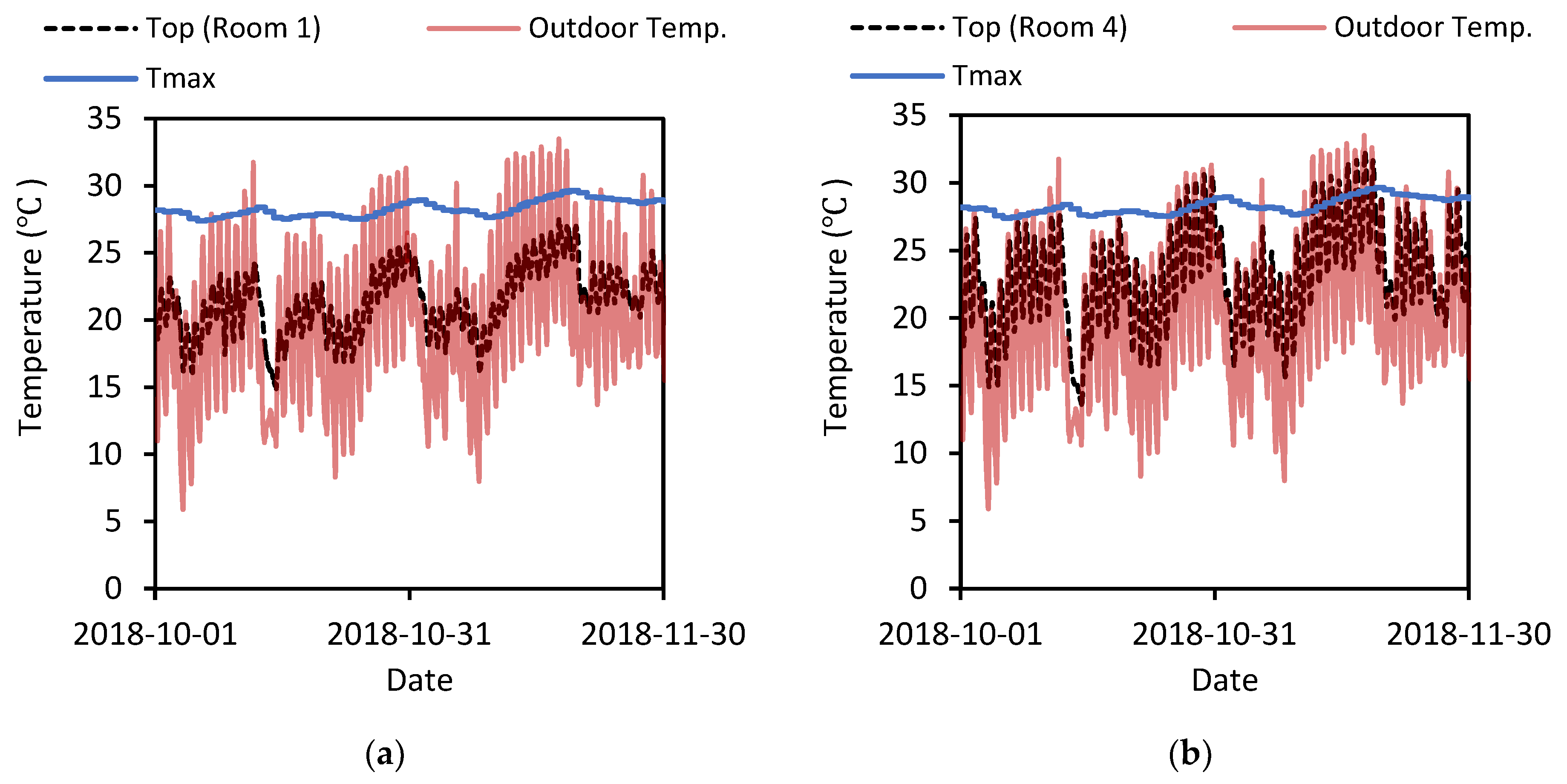

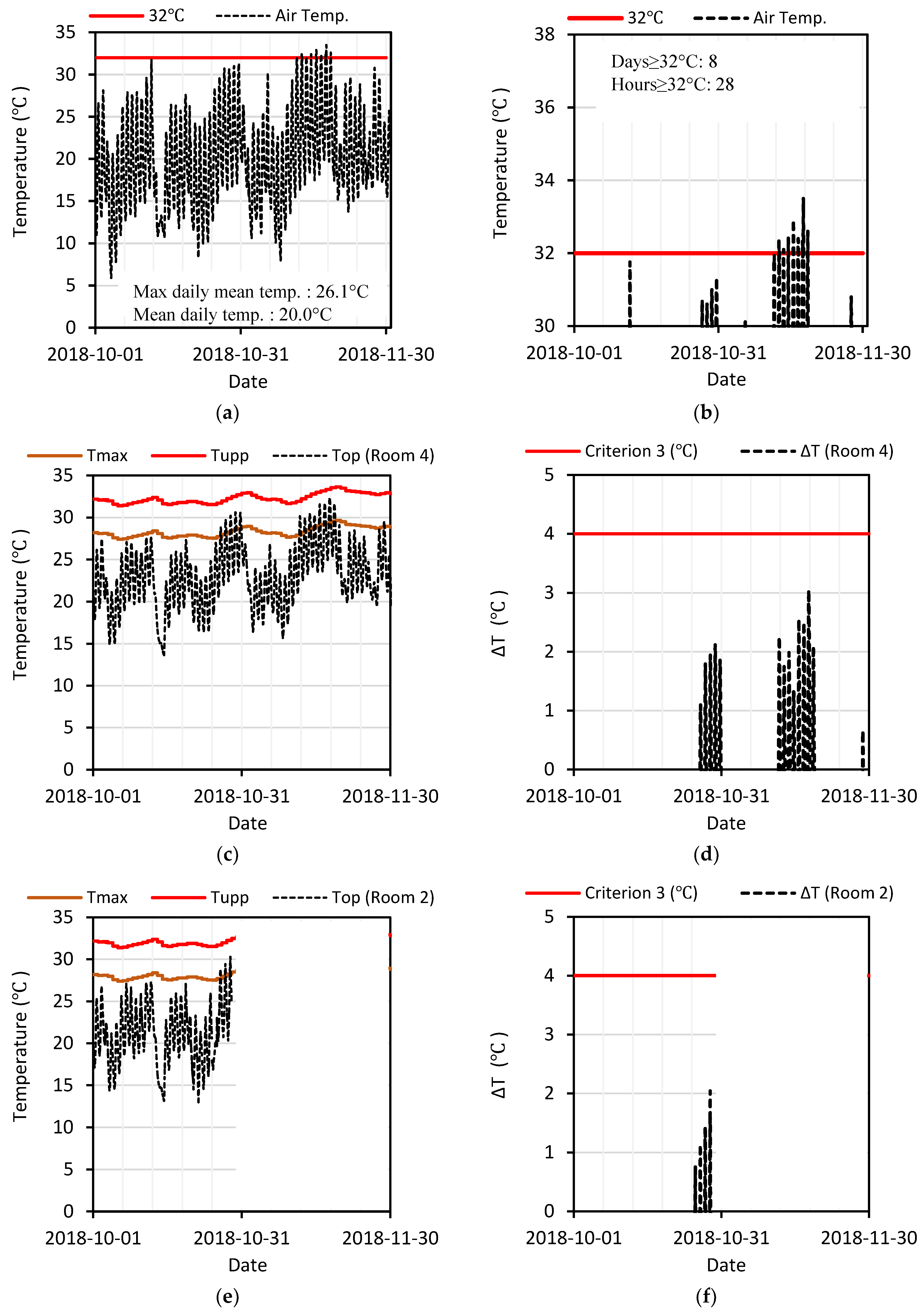
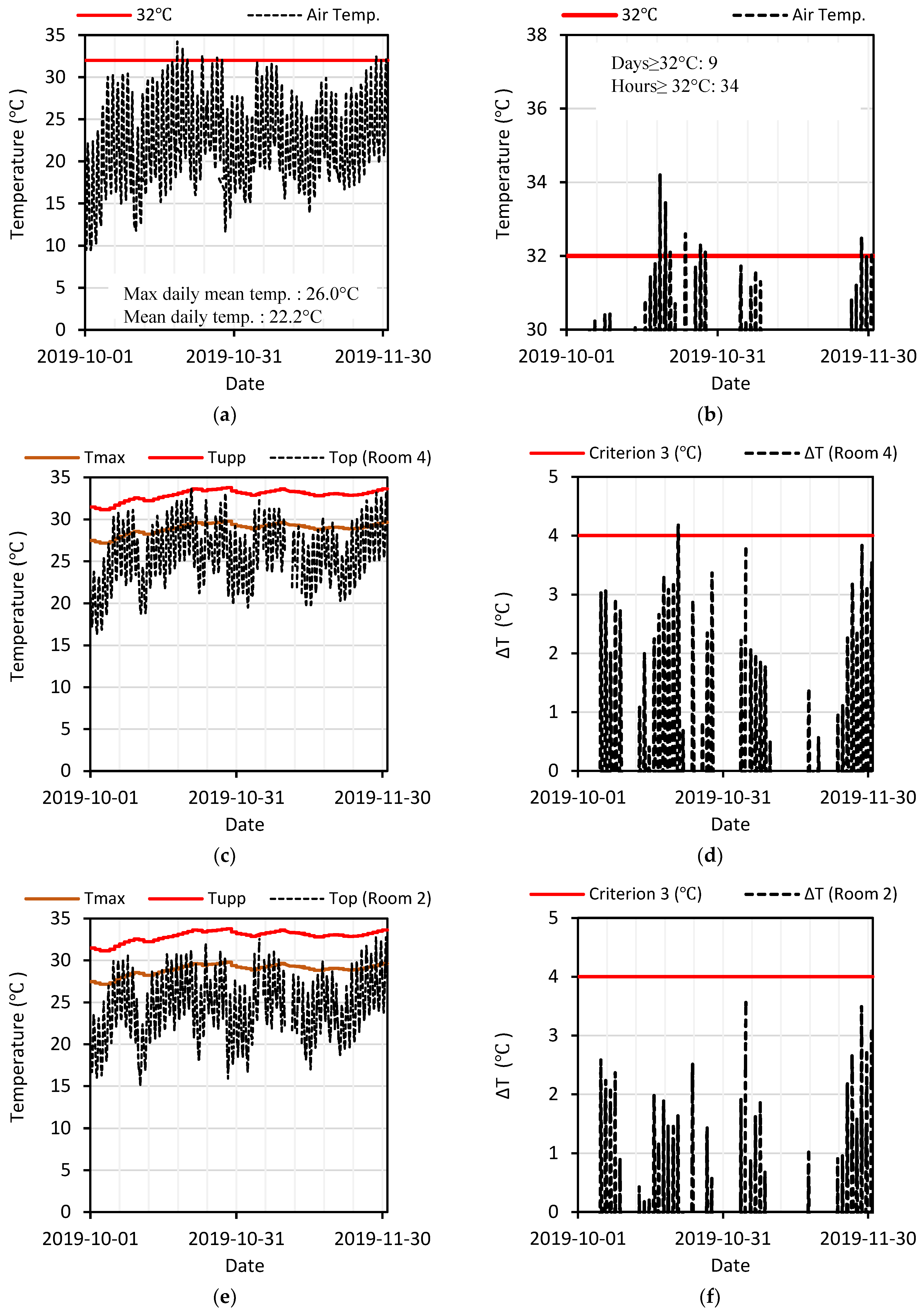

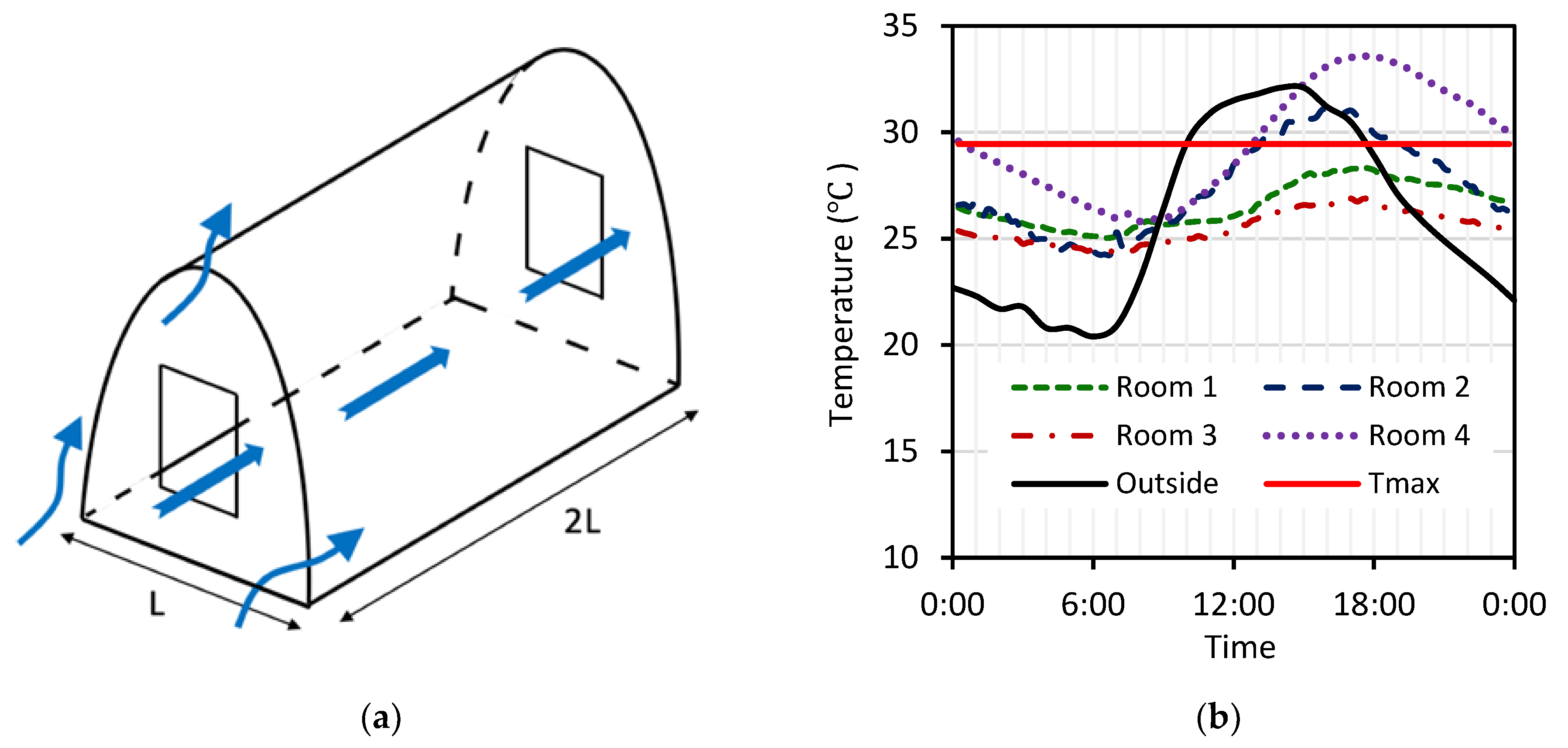
| Year | Average Maximum Temp. (°C) | Rank | ENSO: |
|---|---|---|---|
| 1981–2010 2 | 22.3 | - | - |
| 2015 | 24.2 | 1 | El Niño (very strong) |
| 2018 | 23.2 | 4 | El Niño (weak) |
| 2019 | 23.9 | 2 | Neutral/El Niño (very weak) |
| 2020 | 22.4 | 37 | La Niña (moderate) |
| Year | Average Maximum Temp. (°C) | Daily Mean Temp. (°C) |
|---|---|---|
| 1961–1990 1 | 23.8 | 17.5 |
| 2015 2 | 27.8 | 20.5 |
| 2018 2 | 25.8 | 18.9 |
| 2019 2 | 27.7 | 20.8 |
| 2020 2 | 25.4 | 19.7 |
| Materials Description | U-Value (W/m2K) |
|---|---|
| Solid dry-stack (mortarless) block masonry (220 mm) | 2.11 1 |
| CSEB block masonry (150 mm) with cement-sand plaster (20 mm) | 2.38 1 |
| Window glazing (6.38 mm) (single-glazed low-E glass: 83% transmission of visible light and 70% solar energy) | 3.57 |
| Solid concrete floor slabs (150 mm) on sand (uninsulated) | 1.01 2 |
| Criterion | Assessment Criteria | Limit |
|---|---|---|
| 1 | Percentage of occupied hours during which ΔT ≥ 1 °C | Up to 3% of occupied hours |
| 2 | Daily weighted exceedance (We) in any one day > 6 °Ch (degreeHours) | 0 days |
| 3 | Maximum temperature level (Tupp) ΔT > 4 °C | 0 h |
| Year | Exceed Tmax (Y/N) * | Criterion 1 (<3%) | Criterion 2 (<6 °Ch) | Criterion 3 (<4 °C) | Overheat (Y/N) |
|---|---|---|---|---|---|
| 2018 | Y | Fail (3.4%) | Fail (We = 6.25 °Ch) | Pass (T = 3 °C) | Y |
| 2019 | Y | Fail (12.5%) | Fail (We = 7.75 °Ch) | Pass (T = 3 °C) | Y |
| 2020 | Y | Pass (2.3%) | Pass (We = 4.75 °Ch) | Pass (T = 2 °C) | N |
| Year | Maximum Temp. (°C) | Mean Daily Maximum Temp. (°C) | Daily Mean Temp. (°C) |
|---|---|---|---|
| 2018 | 33.5 | 27.0 | 20.0 |
| 2019 | 34.2 | 29.1 | 22.2 |
| 2020 | 31.3 | 25.6 | 20.5 |
Disclaimer/Publisher’s Note: The statements, opinions and data contained in all publications are solely those of the individual author(s) and contributor(s) and not of MDPI and/or the editor(s). MDPI and/or the editor(s) disclaim responsibility for any injury to people or property resulting from any ideas, methods, instructions or products referred to in the content. |
© 2023 by the author. Licensee MDPI, Basel, Switzerland. This article is an open access article distributed under the terms and conditions of the Creative Commons Attribution (CC BY) license (https://creativecommons.org/licenses/by/4.0/).
Share and Cite
Bradley, R. Vulnerability of Affordable Housing to Global Warming in South Africa: Case Study of a Masonry House in Johannesburg. Buildings 2023, 13, 1494. https://doi.org/10.3390/buildings13061494
Bradley R. Vulnerability of Affordable Housing to Global Warming in South Africa: Case Study of a Masonry House in Johannesburg. Buildings. 2023; 13(6):1494. https://doi.org/10.3390/buildings13061494
Chicago/Turabian StyleBradley, Ryan. 2023. "Vulnerability of Affordable Housing to Global Warming in South Africa: Case Study of a Masonry House in Johannesburg" Buildings 13, no. 6: 1494. https://doi.org/10.3390/buildings13061494





